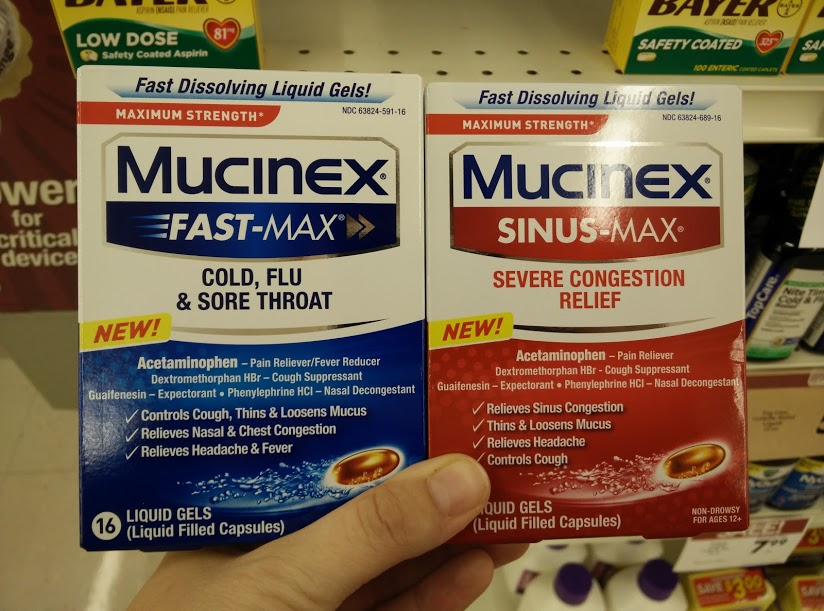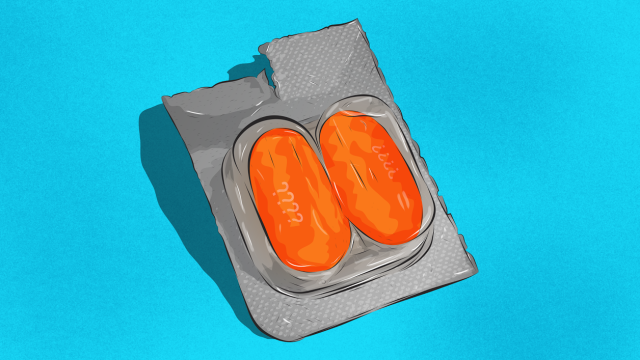There are two ways to pick out your favourite cold medicine when you go to the store. One is to remember the brand name you used last year; the other is to scan the fine print for the right mix of active ingredients. That second approach may sound like a hassle, but it’s much more effective.
Illustration by Sam Woolley.
When your head feels like it’s full of cotton, remembering that you swear by Robitussin isn’t enough to tell you which Robitussin — it would be like going into a shoe store and asking for a pair of Nikes, any Nikes. Some medications that look similar have very different ingredients, and some that look like totally different products are identical on the inside. And I don’t just mean generics versus store brands. Look at this:

These two products look like completely different medicines for different ailments, but they have the exact same dosage of the exact same ingredients. You might be tempted to just pick one and remember the name, but Mucinex doesn’t make that easy: there are multiple “Fast-Max” products and multiple “Sinus-Max” products, each with different formulations — and I found that the active ingredients listed on their website sometimes differ from what’s on the products in store.
Here’s another puzzle. Can you guess the difference between Robitussin Peak Cold Maximum Strength Multi-Symptom Cold and Robitussin Severe Multi-Symptom Cough Cold & Flu? The latter contains acetaminophen, meaning it’s equivalent to taking the other plus Tylenol. Otherwise they’re identical. (Even though one is labelled “maximum strength” and the other isn’t, their dosages are the same.)
The brands keep this complicated, with symptom quizzes and comparison tools on their web sites meant to lead you through the labyrinth of products — but there is a better solution.
Rather than remembering product names, think of each syrup or pill as a toolbox: does it contain the tools you need to do the job? This approach also helps you avoid the ingredients you don’t want, since some have side effects or risks that you may want to avoid.
There are only a handful of ingredients in the multitudes of boxes and bottles in the cold medicine aisle. Knowing those ingredients makes you a smart shopper, your own over-the-counter alchemist of symptom relief. Today, we’ll look at some of the most common ingredients in cold medicines — but you can use the same “toolbox” approach when shopping for other medicines too.
Cough Medicines
Drug: Dextromethorphan
Usually listed as: Cough Suppressant
What it does: Interferes with the brain signals that trigger coughing, although it may not be very effective.
Important to know: The way dextromethorphan acts in the brain makes it a dissociative hallucinogen. (Yes, some people overdose on cold medicines recreationally. Don’t try this at home.) The doses in cold medicine are low enough that you won’t start seeing pink elephants, but they can make you feel weird or loopy. If this bothers you, try a product without this ingredient.
Drug: Guaifenesin
Usually listed as: Expectorant
What it does: Causes mucus in your lungs to become more watery. This means you’ll have more mucus, but it should be easier to cough it up (“expectorate” it).
Important to know: Like dextromethorphan, guaifenesin may not work very well; results are mixed, so try it and see.
Decongestants
Drug: Pseudoephedrine
Usually listed as: Nasal decongestant
What it does: Shrinks blood vessels in the nose, so you make less mucus.
Important to know: While this is an “over the counter” drug, with no prescription required in most states, pharmacists are obligated to store it behind the counter (or in a locked cabinet). That’s because it can be used to make methamphetamine, so it comes with some extra regulations. This also means that if you know you want a pseudoephedrine-containing drug, go shopping when your store’s pharmacy counter is open. Side effects can include feeling jittery and having trouble sleeping.
Drug: Phenylephrine
Usually listed as: Nasal decongestant
What it does: Shrinks blood vessels in the nose (same idea as pseudoephedrine)
Important to know: The drugs that used to contain pseudoephedrine have mostly been reformulated: the versions available on store shelves now contain phenylephrine instead, which works in a similar way and has similar side effects. It’s less effective than pseudoephedrine, though, so consider upgrading to the behind-the-counter stuff if it doesn’t seem to work for you.
Sleepy Makers
Drug: Diphenhydramine
Usually listed as: Antihistamine
What it does: Interferes with histamine receptors, making you sleepy and reducing allergy symptoms (it’s complicated)
Important to know: This is a drug with two very different purposes. In some medications it is an antihistamine that counters allergy symptoms; in others it’s a sleep aid. Same drug, different branding. It shows up in nighttime formula cold medicines to “help you sleep,” although it can be powerful and sometimes longer-lasting than you expect, so use it with caution if you know you’ll have to wake up early.
Drug: Doxylamine
Usually listed as: Antihistamine
What it does: Same as diphenhydramine, making you sleepy and reducing allergy symptoms
Important to know: Very similar to diphenhydramine, although some people find that one works better for them than the other.
Pain Relievers
Drug: Acetaminophen
Usually listed as: Pain Reliever
What it does: Reduces pain and lowers fever temperatures
Important to know: Acetaminophen can cause liver damage if you overdose, and since it’s in multiple products (many cold medicines) it’s possible to get too much. Labels now have to carry a warning about this, which also includes the caveat not to take acetaminophen if you’re drinking alcohol.
Drug: Naproxen
Usually listed as: Pain reliever
What it does: Reduces pain, inflammation, and fever
Important to know: Naproxen doesn’t have the same toxicity issues as acetaminophen, but is used for similar purposes. It lasts longer in the body than ibuprofen, so you’ll find it in long-acting medicines.
Drug: Ibuprofen
Usually listed as: Pain reliever
What it does: Reduces pain, inflammation, and fevers
Important to know: This one is less common in cold medicines, but is good to know about. It’s very similar to naproxen, but is shorter acting.
Other Things to Know
A few caveats apply to all cold medicines, and to label-reading in general:
- Beware giving these medications to kids. Even the ones labelled as “children’s” aren’t recommended for kids under 4: they may not work, and may carry extra risks. If you really think your kid needs something, it’s worth a call to the doctor first.
- If you’re taking more than one medication, check the labels carefully to make sure you’re not doubling up on something (especially acetaminophen).
- While you’re at it, read the whole label, including warnings on how the medicine interacts with other drugs or health conditions that might apply to you.
Shopping for cold medicines by ingredient really is like selecting tools for a job. When you know which ones you need and which ones you don’t, you can pick exactly what works for you.

Comments
16 responses to “How To Make Sense Of The Countless, Confusing Cold Medicines Out There”
I got caught last week selecting some Day/Night pill packs, and thought I was picking up a standard pharmacy generic but in fact got some ridiculous herbal concoction packaged to look like the real thing. They had day/night colours and different shaped pills with identical ineffective ingredients. It was actually a little more expensive than the pharmaceuticals it had been shelved with.
Garlic & Horseradish, nuff said.
most of these, if not all don’t work any better than an NSAID (aspirin, paracetamol, ibuprofen)
they usually are an NSAID + as the article said, guaifenesin, phenylephrine, dmx, codeine, none of these have very solid evidence behind them for “that particular use”
why bother spending upwards of $10 when you can buy a decent generic ibuprofen 24 pack at coles for less than $2, and will more than likely do the same.
Because while the active ingredient is the same, the composition of the compound may cause reactions to the consumer.
I have a relative who’s a celiac and said relative often goes for the name brand because the generic brand has gluten in the compound.
The best way to make sense of it all is just to ask the pharmacist.
Can I also add, DO NOT GO TO HOSPITAL, you have a cold and/or flu, no – you are not dying and frankly, it makes you look like a wuss that can’t handle a sore throat. Bedrest & fluids will help you. Antibiotics do nothing but make you resistant & cold/flu medications mentioned above only help with symptoms, not cure it. (Registered Nurse that deals with people suffering from man-flu).
just go to the pharmacy and ask the pharmacist, whatever is on offer at the supermarkets is just basically a placebo.
That’s not true at all. Pills with the listed ingredients here are available at all supermarkets. pharmacists have access to the stronger formulations (things with Codeine, more paracetamol etc). But pharmacies also sell more of the useless placebos too. Usually it makes up at least half the inventory of “medicine” on their shelves. They always have those cardboard promo stands with that useless crap in there too.
Asking the pharmacist is usually a good way to go, yes, they usually give very good advice. But even then there are bad ones: naturapath pharmacists etc.
please if the supermarket drugs actually did anything useful, you would have to talk to a pharmacist before you could purchase them.
when it comes to cold and flu medicine if its not ‘pharmacy only medicine’ then its not worth buying
Of course they’re real drugs. You can even buy enough paracetamol to kill yourself if you’d like.
The formulations at the supermarket are just safer that’s all because dosages of dangerous stuff is lower.
Its simple,
paracetamol for fevers and general whiny sicknesses,
Codeine for stronger pain
any psuedoephedrine based product for congested sinuses.
and Voltaren rapi 25s for inflammation
Except influenza does actually kill people even some young people. I agree with the statement about colds but influenza is not equivalent to a cold! (Registered Nurse – Emergency Dep – who also looks after people suffering man-flu but sometimes that cry baby actually is dying – awkward when you’re wrong) 😛
Just to help the local copywriters “Australianise” the article
Acetaminophen = paracetamol
And naxproxen isn’t included in cold/flu preparations here. Without prescription, it’s only licensed for period pain.
Zinc, Echinacea, Garlic and VIt C
in individual pill form.
does almost nothing
thats funny, i didnt realise you knew my body better then i do.
ive taken those supplements and got better within 2 days almost every time ive caught a cold or flu.